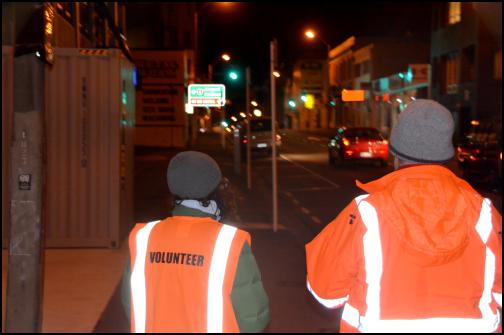Wellington’s First Street Count of Rough Sleepers
Wellington’s First Street Count of Rough
Sleepers

Last night 50 volunteers helped in Wellington’s first ever count of rough sleepers. The project was headed by Te Aro Health Centre, the Soup Kitchen, and Wellington City Council.
The count itself was undertaken between the hours of 4 and 6 am on the morning of Friday the 8th of August, turning up a final statistic of 15 rough sleepers.
The counters searched and recorded data using a single point in time approach to count rough sleepers in every block of the city’s downtown area but only known locations in the outlying suburban parts of the city.
This is Wellington’s first count of the homeless, despite regular counts being a common trend in other cities around the world such as Sydney, in every US state, all counties in the UK, and in NZ’s own city of Auckland.
Stephanie Lacey, from the Wellington City Council, said that targeted council funding will be more informed with data collected from the count, along with other data from the Downtown Community Ministry and Outreach.
Counters were recruited from Te Aro, The Soup Kitchen, Wellington City Council, and other community partners such as Regional Public Health, Night Shelter and the Downtown Community Ministry.
Each counter was partnered with a volunteer member of the community recruited from Rotary Club, Central Baptist Church and willing and able-bodied friends and family.
Wellington Police has supported the planning and safety of the counters themselves.
Wilsons parking security guards conducted their own survey to contribute to the count within private car park buildings owned by Wilsons
The idea for the count was first proposed by Dr Jill Wilkinson an advisor to the board of Te Aro Health Centre and lecturer of in the Shcool of Nursing at Massey University.
Its aim is to provide accurate and up to date information about the number of homeless people in Wellington, to ensure the right programmes are in place that will address the need.
In other cities where counts are conducted regularly the results are used to inform council and government policy and to address the ongoing issue of homelessness.
The street count is part of Wellington City Council’s project Te Mahana: Ending Homelessness in Wellington Strategy whose ultimate aim is to end homelessness in Wellington by 2020.
Some goals of the Te Manaha project include; improvements of affordability and access to housing, decrease in evictions, targeted health support and development of “pre-discharge protocols and guidelines for people leaving prisons, hospitals, community health facilities.”
There is a big gap in services that support people trying to get off the streets, “particularly with finding the right kind of housing for people,” said Stephanie Lacey.
The street count’s
predominant goals are to connect homeless people to social
services available to them and also provide data, which will
better prepare these services to accommodate and assign
resources to people who need them.
“It is very likely there will be
a budget for successive future counts” said Jenny Rains,
community services manager for the Wellington City
Council.
ENDS


 Gordon Campbell: On The Clash Between Auckland Airport And Air New Zealand
Gordon Campbell: On The Clash Between Auckland Airport And Air New Zealand Fire and Emergency NZ: Check Your Smoke Alarms When Clocks Go Back This Sunday
Fire and Emergency NZ: Check Your Smoke Alarms When Clocks Go Back This Sunday NZ Government: Repeal Of 7AA Puts Child Wellbeing First
NZ Government: Repeal Of 7AA Puts Child Wellbeing First NZ Government: Reducing Ambiguity About What Is Reasonably Practicable For Health And Safety Compliance
NZ Government: Reducing Ambiguity About What Is Reasonably Practicable For Health And Safety Compliance Office of the Speaker: New Zealand Parliamentarians Attend 150th IPU Assembly
Office of the Speaker: New Zealand Parliamentarians Attend 150th IPU Assembly RNZRSA: RNZRSA Supports Willie Apiata VC's Stand To Drive Change To Veterans’ Support Act
RNZRSA: RNZRSA Supports Willie Apiata VC's Stand To Drive Change To Veterans’ Support Act Diane McCarthy - LDR: War Hero Willie Apiata Entrusts MP With Victoria Cross Medal
Diane McCarthy - LDR: War Hero Willie Apiata Entrusts MP With Victoria Cross Medal


